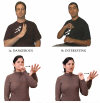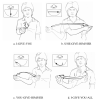THE PHONOLOGICAL ORGANIZATION OF SIGN LANGUAGES
- PMID: 23539295
- PMCID: PMC3608481
- DOI: 10.1002/lnc3.326
THE PHONOLOGICAL ORGANIZATION OF SIGN LANGUAGES
Abstract
Visually perceivable and movable parts of the body - the hands, facial features, head, and upper body - are the articulators of sign language. It is through these articulators that that words are formed, constrained, and contrasted with one another, and that prosody is conveyed. This article provides an overview of the way in which phonology is organized in the alternative modality of sign language.
Figures




















References
-
- Ann Jean. PhD dissertation. University of Arizona; Tucson: 1993. A linguistic investigation of the relationship between physiology and handshape.
-
- Ann Jean. A functional explanation of Taiwan Sign Language handshape frequency. Language and Linguistics. 2005;6:217–246.
-
- Aronoff Mark, Meir Irit, Padden Carol, Sandler Wendy. Classifier constructions and morphology in two sign languages. In: Emmorey Karen., editor. Perspectives on classifier constructions in sign languages. Lawrence Erlbaum Associates; Mahwah, NJ: 2003. pp. 53–85.
-
- Baker-Shenk Charlotte. A microanalysis of the nonmanual components of questions in American Sign Language. University of California Press; Berkley: 1983.
Grants and funding
LinkOut - more resources
Full Text Sources
